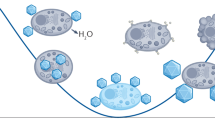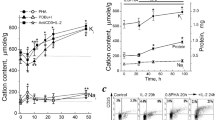Abstract
CELLS die if cooled either too rapidly or too slowly during freezing in the presence of dimethylsulphoxide (DMSO)1–4, but survive at an intermediate optimal cooling rate5. We have now obtained improved recovery of lymphocytes, lymphoid cell line cells and Chinese hamster tissue culture cells by interrupting rapid cooling with a timed exposure to a single subzero temperature. This method is simple and here we put forward some theoretical reasons for the improved cell recovery.
This is a preview of subscription content, access via your institution
Access options
Subscribe to this journal
Receive 51 print issues and online access
$199.00 per year
only $3.90 per issue
Buy this article
- Purchase on Springer Link
- Instant access to full article PDF
Prices may be subject to local taxes which are calculated during checkout
Similar content being viewed by others
References
Farrant, J., Knight, S. C., and Morris, G. J., Cryobiology, 9, 516–525 (1972).
Leibo, S. P., Farrant, J., Mazur, P., Hanna, M. G., and Smith, L. H., Cryobiology, 6, 315–332 (1970).
Mazur, P., Farrant, J., Leibo, S. P., and Chu, E. H. Y., Cryobiology, 6, 1–9, (1969).
Morris, G. J., and Farrant, J., Cryobiology, 9, 173–181 (1972).
Knight, S. C., Farrant, J., and Morris, G. J., Nature new Biol., 239, 88–89 (1972).
Pegg, D. E., Laboratory Practice, 15, 772–773 (1966).
Pegg, D. E., and Hayes, A. R., Phys. med. biol. 15, 409–416 (1970).
McGann, L. E., Kruuv, J., and Frey, H. E., Cryobiology, 9, 494–501, (1972).
La cryoconservation des cellules normales et neoplasiques, (edit. by Weiner, R. S., Oldham, R. K., and. Schwarzenberg, L.) (INSERM, Paris, 1973).
Luyet, B., and Keane, J., Biodynamica, 7, 281–292 (1955).
Taylor, A. C., Ann. N. Y. Acad. Sci., 85, 595–609 (1960).
Smith, A. U., Biological Effects of Freezing and Supercooling, (Arnold, London, 1961).
Hors, J., Preud'homme, J. L., Toulze-Zapateria, M. T., Guillet-Bigot, J., Roy, J. P., and Dausset, J., Transplantation, 15, 417–419 (1973).
Farrant, J., and Morris, G. J., Cryobiology, 10, 134–140 (1973).
Lovelock, J. E., Br. J. Haemat., 1, 117–129 (1955).
Morris, G. J., and Farrant, J., Cryobiology, 10, 119–125 (1973).
Author information
Authors and Affiliations
Rights and permissions
About this article
Cite this article
FARRANT, J., KNIGHT, S., MCGANN, L. et al. Optimal recovery of lymphocytes and tissue culture cells following rapid cooling. Nature 249, 452–453 (1974). https://doi.org/10.1038/249452a0
Received:
Issue Date:
DOI: https://doi.org/10.1038/249452a0
This article is cited by
-
Cryopreservation ofTheileria-infected lymphoblastoid cells with functional assessment of viability
Tropical Animal Health and Production (1986)
-
The maintenance of B-cell and T-cell function in frozen and stored human lymphocytes
Journal of Clinical Immunology (1981)
-
Cooling velocity and cell recovery (reply)
Nature (1975)
-
Cooling velocity and cell recovery
Nature (1975)
Comments
By submitting a comment you agree to abide by our Terms and Community Guidelines. If you find something abusive or that does not comply with our terms or guidelines please flag it as inappropriate.



